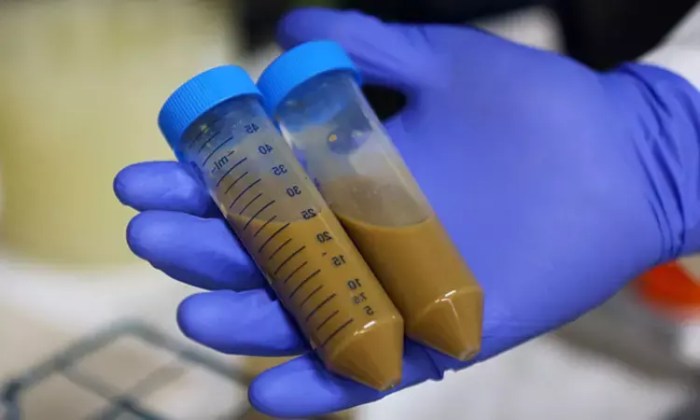Why you shouldnt try a fecal transplant at home – Why you shouldn’t try a fecal transplant at home: This isn’t a DIY project. Fecal transplants, while sometimes a necessary medical intervention, are complex procedures that require careful medical supervision. Ignoring this crucial element can lead to serious health consequences. From the potential for infections and allergic reactions to the technical difficulties in proper administration, the risks far outweigh any perceived benefits of a DIY approach.
This comprehensive guide explores the various risks associated with attempting a fecal transplant at home, from the potential introduction of harmful bacteria to the critical need for sterile conditions and precise dosages. We’ll also discuss the importance of medical expertise, legal implications, and alternative treatment options. Understanding these factors is crucial for anyone considering this procedure.
Risks of Home Fecal Transplants
DIY fecal transplants, while tempting for some, pose significant health risks. The intricate balance of gut bacteria and the potential for introducing harmful organisms make this a procedure best left to trained medical professionals. The risks associated with home fecal transplants far outweigh any perceived benefits, and could lead to serious health complications.The process of fecal transplantation, even under the most sterile conditions, involves a transfer of microorganisms from one individual to another.
A miscalculation in preparation or administration, or a failure to maintain strict hygienic standards, can have catastrophic consequences. A lack of medical oversight and the absence of trained personnel to monitor the procedure greatly increases the potential for adverse events.
Potential Health Complications
Performing a fecal transplant at home significantly increases the risk of introducing harmful bacteria or pathogens into the recipient’s body. Improper handling and administration techniques can lead to a variety of health complications. The lack of sterile conditions during a home procedure can be a breeding ground for infections.
- Infections: The most immediate risk is the introduction of pathogenic bacteria or viruses. Improper fecal collection, storage, or administration can lead to serious infections. This could range from mild gastrointestinal issues to life-threatening systemic infections, potentially spreading to other parts of the body.
- Allergic Reactions: The recipient may have an allergic reaction to the donor’s fecal matter. This can manifest as skin rashes, hives, or more severe symptoms, such as difficulty breathing or swelling of the throat. Reactions to proteins or other components within the fecal matter can occur. The lack of immediate medical attention in a home setting makes this a significant risk.
- Other Adverse Events: These can include abdominal pain, nausea, vomiting, and diarrhea. While these symptoms might not be life-threatening, they can be extremely unpleasant and disruptive. Some recipients experience long-term digestive issues. Furthermore, there’s a possibility of spreading infectious diseases through improper handling and administration.
- Contamination: Improper storage of the fecal matter or inadequate sanitation procedures can lead to contamination. Contamination by external sources, such as bacteria or viruses, can quickly spread to the recipient during the procedure.
Risk of Introducing Harmful Bacteria and Pathogens
The human gut is a complex ecosystem teeming with bacteria, both beneficial and harmful. A home fecal transplant disrupts this balance and introduces a significant risk of contamination. This could introduce harmful bacteria or pathogens that are not present in the recipient’s gut, causing an infection or exacerbating existing conditions.
- Introducing Unknown Microbes: The donor’s fecal matter may contain microorganisms that could be harmful to the recipient. The donor’s health status, hygiene practices, and the presence of undiagnosed infections could contribute to introducing harmful pathogens.
- Exacerbating Existing Conditions: Individuals with compromised immune systems are at an even greater risk of infection. The introduction of harmful bacteria or pathogens could worsen existing health issues or lead to complications.
Risk of Spreading Infectious Diseases
The risk of spreading infectious diseases through improper fecal handling and administration techniques is significant. A home setting lacks the necessary precautions and expertise to prevent the transmission of pathogens.
- Cross-Contamination: Improper fecal handling and administration can lead to cross-contamination. This can expose the recipient and other individuals in the household to potential infections.
- Infectious Agents: The donor’s fecal matter may contain infectious agents that can be transmitted to the recipient. The lack of proper sanitation and isolation can lead to outbreaks.
Lack of Sterile Conditions
The lack of sterile conditions during a home procedure can lead to serious health problems. Medical facilities maintain rigorous standards for sterility to minimize the risk of infection.
- Contaminated Equipment: Home procedures often lack access to sterile equipment, increasing the risk of introducing harmful microorganisms.
- Improper Technique: The lack of medical supervision and training can lead to improper technique and procedures, leading to contamination and infections.
Comparison of Risks
Technical Challenges of Home Procedures: Why You Shouldnt Try A Fecal Transplant At Home
Attempting a fecal microbiota transplant (FMT) at home presents significant hurdles, primarily due to the delicate nature of the procedure and the stringent requirements for sterile technique. While the concept of self-administration might seem appealing, the technical complexities involved in safely collecting, preparing, and administering the fecal material at home pose considerable risks. These risks significantly outweigh the potential benefits and underscore the importance of seeking professional medical guidance.The process of safely administering a fecal transplant requires meticulous attention to detail, precise measurements, and strict adherence to sterile conditions.
Failure to meet these criteria can lead to serious complications, highlighting the need for expertise and medical supervision. Home procedures lack the controlled environment and specialized equipment that a medical facility provides, significantly increasing the potential for errors and adverse events.
Collecting Fecal Material
Proper collection of fecal material is crucial for a successful FMT. This involves using sterile containers and techniques to minimize contamination. Home environments, however, often lack the necessary sterile equipment and conditions. Ensuring the fecal sample is free from contaminants like bacteria or viruses is vital, yet this is challenging to achieve without medical supervision. The sample’s quality and handling directly impact the procedure’s efficacy.
Preparing the Fecal Sample
The preparation of the fecal sample is another critical step in FMT. This typically involves filtering or processing the material to remove impurities and maintain a suitable consistency for administration. At home, replicating these precise preparation techniques is difficult. The lack of specialized equipment and the potential for contamination during this stage can lead to a compromised sample, making the transplant less effective or even harmful.
Administering the Fecal Sample
Accurate administration of the fecal sample is essential to maximize its therapeutic effect. This involves precise measurements and proper insertion techniques. At home, without medical guidance, achieving these precise measurements and administering the material in the correct manner is difficult. A miscalculation in dosage or improper administration could lead to a negative outcome. The specific needs of the recipient’s condition must also be taken into consideration.
Sterile Techniques and Home Procedures
Maintaining sterile conditions is paramount in FMT procedures. Medical facilities have dedicated environments and specialized equipment to ensure sterility. Home environments often lack these critical components, making it extremely challenging to maintain the necessary sterility levels. This is crucial to prevent contamination and infection. Even seemingly minor breaches in sterile technique can lead to complications.
Precise Measurements and Dosages, Why you shouldnt try a fecal transplant at home
Precise measurements and dosages are critical in FMT. The optimal dose varies based on individual needs and the recipient’s condition. Without medical guidance and the specialized equipment for precise measurements, it is difficult to determine the appropriate dose at home. Incorrect dosages can result in adverse effects, underscoring the need for medical oversight.
Step-by-Step Guide and Challenges
A step-by-step guide for a home FMT procedure would likely include collecting the fecal sample, preparing it, and administering it. However, the challenges in safely and accurately performing each step, including maintaining sterile conditions, accurately measuring the dose, and ensuring correct administration technique, are significant.
Equipment Comparison
| Equipment | Medically Supervised Procedure | Home Procedure |
|---|---|---|
| Sterile Containers | Available in various sizes and types | Potentially contaminated, non-sterile |
| Specialized Equipment for Sample Preparation | Centrifuges, filters, etc. | Absent, potentially creating contamination risks |
| Precise Measurement Tools | Graduated cylinders, pipettes | Household measuring tools, likely inaccurate |
| Sterile Environment | Dedicated clean room | Potentially contaminated home environment |
| Medical Supervision | Expert guidance, monitoring | Lack of supervision, potential for errors |
Lack of Medical Supervision and Expertise

Fecal microbiota transplantation (FMT) is a complex procedure, requiring meticulous attention to detail and expert oversight. Attempting this procedure at home significantly reduces the safety and efficacy of the treatment. The delicate balance of the gut microbiome and the potential for complications necessitate the expertise of a trained medical professional.Medical professionals possess a crucial role in FMT, extending far beyond simply administering the procedure.
Their expertise is essential for monitoring patients’ health throughout the process, from pre-transplant evaluation to post-transplant follow-up. This comprehensive approach ensures optimal patient outcomes and mitigates potential risks.
Crucial Role of Medical Professionals in Monitoring
Medical professionals play a critical role in monitoring patients undergoing fecal transplants. They meticulously track patient vital signs, assess for any adverse reactions, and promptly address emerging complications. This constant monitoring allows for early intervention, preventing potential complications from escalating into serious health issues. For example, if a patient experiences fever, abdominal pain, or other symptoms post-transplant, a medical professional can quickly diagnose and treat the issue, potentially preventing further complications.
Importance of Expert Medical Guidance in Identifying Complications
Expert medical guidance is essential in identifying and managing potential complications arising from fecal transplants. Complications can range from mild discomfort to severe, life-threatening conditions. A gastroenterologist, with their specialized knowledge and experience, can accurately diagnose and manage these complications. This includes conditions like infections, allergic reactions, or even bowel obstructions. A home procedure lacks the capability to promptly and effectively address such issues.
Determining Appropriate Fecal Donor and Recipient Match
The selection of a suitable fecal donor and recipient is paramount. Medical professionals possess the expertise to evaluate potential donors for infectious diseases, genetic predispositions, and other relevant factors. They also meticulously assess the recipient’s medical history and current health status. This comprehensive evaluation ensures that the transplant is performed safely and effectively. A home procedure lacks the necessary tools and expertise to conduct these critical assessments.
Trying a fecal transplant at home is a definite no-go. It’s a complex procedure involving delicate microorganisms and precise dosing, which are best handled by a medical professional. Understanding the intricacies of your own gut microbiome is crucial, but it’s not something you should experiment with. For example, did you know how much your organs weigh? Checking out how much do your organs weigh might help you appreciate just how sensitive your internal workings are.
Ultimately, leaving fecal transplants to the experts is the safest route to ensure a healthy outcome.
Potential for Misdiagnosis and Inappropriate Treatment
Without the expertise of a medical professional, there is a significant risk of misdiagnosis and inappropriate treatment. Home procedures lack the diagnostic tools and experience to identify and manage complications accurately. Symptoms may be misinterpreted, leading to delayed or ineffective treatment. A simple fever, for example, could be mistaken for a less serious condition, potentially delaying the identification of a more serious underlying issue.
Trying a fecal transplant at home is a definite no-go. It’s a complex procedure that requires sterile conditions and careful monitoring by medical professionals. While some might be tempted to try and save money by experimenting with DIY methods, it’s incredibly important to avoid this. Think about the potential risks, especially when you consider the importance of proper sanitation and the wide range of foods high in sodium, like processed meats and canned goods , which can greatly impact your health.
Ultimately, a fecal transplant should always be done under the supervision of a doctor.
Expertise Comparison: Gastroenterologist vs. Home Practitioner
A gastroenterologist possesses specialized training and experience in diagnosing and treating gastrointestinal disorders, including conditions that may benefit from fecal transplants. They have extensive knowledge of the human gut microbiome, the potential complications of FMT, and the appropriate protocols for donor selection and recipient preparation. In contrast, someone attempting a home procedure lacks this specialized knowledge, experience, and the necessary resources to manage potential complications effectively.
A gastroenterologist can draw on years of study and experience to guide the procedure, while a home practitioner does not have this training or experience.
Legal and Ethical Considerations
Home fecal transplants, while potentially beneficial, carry significant legal and ethical implications that must be carefully considered. The process involves handling potentially sensitive biological material, and deviations from established medical protocols can lead to serious consequences for both the donor and recipient. Understanding these considerations is crucial for ensuring responsible and safe practice.
Legal Ramifications of Unsupervised Procedures
The legal landscape surrounding medical procedures, including fecal transplants, is complex and varies by jurisdiction. Performing a fecal transplant without proper authorization or medical supervision carries substantial legal risks. Failure to adhere to established medical guidelines can expose individuals to potential lawsuits if adverse events occur. This includes cases where complications arise due to the use of contaminated or inappropriate donor material, inadequate preparation of the recipient, or lack of post-procedure monitoring.
Such negligence could result in substantial financial penalties, professional sanctions, or even criminal charges depending on the severity of the harm caused. For instance, if a home procedure leads to severe infection or other health complications in the recipient, the individual performing the procedure could face legal repercussions.
Potential Legal Liabilities
Adverse events stemming from a home fecal transplant can lead to significant legal liabilities. These liabilities can include medical malpractice claims, negligence lawsuits, and potential criminal charges if the actions of the individual performing the procedure are deemed reckless or intentionally harmful. The lack of proper medical oversight in a home setting significantly increases the risk of complications.
Moreover, the difficulty in establishing causation between the procedure and the adverse event can make defending against legal claims challenging. This is especially true when there is a lack of documented procedures, monitoring, and records associated with the home procedure. The absence of a structured medical record-keeping system makes it difficult to prove the effectiveness of the procedure or to attribute any adverse outcomes to the procedure itself, making the individual performing the procedure more vulnerable to legal action.
Ethical Concerns Surrounding Fecal Material Use
Ethical concerns surrounding the use of fecal material for therapeutic purposes are substantial, particularly in a home setting. The collection, handling, and administration of fecal material raise questions about patient autonomy, informed consent, and potential exploitation. The ethical implications of using fecal material for therapeutic purposes necessitate careful consideration of the donor-recipient relationship, the potential psychological impact on both parties, and the overall safety of the procedure.
There are ethical considerations concerning the potential for misuse or exploitation, particularly in a home setting where oversight and accountability are significantly reduced.
Ethical Considerations of Informed Consent and Recipient Rights
Obtaining informed consent in a home setting for a fecal transplant is crucial. The recipient must be fully informed about the risks, benefits, and alternatives to the procedure. Furthermore, they must understand the limitations of a home procedure compared to a medical setting. In a home setting, the recipient’s rights to informed consent and refusal of treatment might be compromised due to the lack of a qualified medical professional present.
Moreover, the recipient’s autonomy and right to make informed decisions about their health care must be respected. The recipient’s rights to privacy and confidentiality must also be ensured. This includes protecting the privacy of the donor and recipient’s information, as well as preventing the unauthorized use or disclosure of such information.
Table Summarizing Legal and Ethical Implications
| Aspect | Home Fecal Transplant | Medical Fecal Transplant |
|---|---|---|
| Legal Ramifications | Higher risk of legal action due to lack of supervision, potential for complications, and difficulty proving causation. | Lower risk of legal action due to established protocols, medical oversight, and documented procedures. |
| Ethical Considerations | Potential for exploitation, compromised informed consent, and diminished recipient rights. | Emphasis on informed consent, patient autonomy, and upholding ethical standards of medical practice. |
| Liability | Higher individual liability due to the absence of institutional safeguards and protocols. | Shared liability among healthcare professionals and institutions, with clear protocols and responsibilities. |
| Patient Safety | Lower safety standards and greater risk of adverse events. | Higher safety standards and protocols to minimize risks and complications. |
Alternative Treatment Options
Fecal microbiota transplantation (FMT) is often considered a last resort for certain digestive issues. Fortunately, a range of other medical treatments can address similar conditions with significantly lower risk. These conventional approaches often offer comparable or superior results, avoiding the complex and potentially dangerous procedure of a home FMT. This section explores various alternative medical treatments, their safety profiles, and how they can effectively address conditions often targeted by FMT.
DIY fecal transplants are a big no-no. The risks are serious, and it’s crucial to understand the complexities involved. While we’re on the topic of medical procedures that shouldn’t be attempted at home, it’s important to remember that some conditions, like tardive dyskinesia, can be challenging to treat, but learning more about the possibility of reversibility can be key, as detailed in this resource on is tardive dyskinesia reversible.
Ultimately, sticking to professional medical guidance for any health concerns, especially those involving bodily functions, is the safest approach.
Medical Treatments for Conditions Often Addressed by FMT
Conventional medical approaches, including antibiotic therapy, dietary modifications, and targeted medications, offer viable solutions for many gastrointestinal issues. These methods typically involve a more gradual and monitored approach to recovery.
- Antibiotic Therapy: Specific antibiotics can target and eliminate harmful bacteria that may be contributing to dysbiosis. Examples include metronidazole and vancomycin. The safety and effectiveness of these treatments vary depending on the underlying condition and the specific antibiotic used. A healthcare professional will carefully consider the patient’s overall health and potential drug interactions before prescribing antibiotics.
- Dietary Modifications: Adjustments to the diet can significantly impact the gut microbiome. Eliminating certain foods or introducing prebiotics and probiotics can promote the growth of beneficial bacteria. This approach is often tailored to individual needs and conditions, with a healthcare professional guiding the process. For instance, a low-FODMAP diet (restricting fermentable oligosaccharides, disaccharides, monosaccharides, and polyols) can be helpful for patients with irritable bowel syndrome (IBS).
- Targeted Medications: Various medications address specific symptoms and underlying causes of gastrointestinal conditions. These might include anti-inflammatory drugs, immunomodulators, or medications that directly address the condition, like medications for Crohn’s disease or ulcerative colitis.
- Probiotic Supplements: Probiotics are live microorganisms, typically beneficial bacteria, that can improve the balance of the gut microbiome. They are available in various forms, including pills, powders, and yogurt. While generally safe, their effectiveness in treating specific conditions varies. Consulting a doctor is recommended before starting any probiotic regimen.
Safety and Effectiveness of Conventional Approaches
Conventional medical treatments generally have established safety profiles when administered under medical supervision. Antibiotics, for example, while having potential side effects, are carefully monitored by physicians to minimize harm. Dietary modifications, while requiring patient adherence, can be adjusted based on individual responses. Probiotic supplements, while often well-tolerated, may not be suitable for all patients, and their effectiveness in treating specific conditions is not consistently proven.
These conventional approaches are typically more manageable and safer than attempting a home fecal transplant.
Non-Invasive Procedures
Non-invasive procedures offer another alternative to FMT. These methods often focus on restoring or improving the gut microbiome without the risks of a complex, invasive procedure. Examples include using prebiotics and probiotics in different ways, or dietary changes to help restore the balance of the gut microbiome.
Comparison Table
| Characteristic | Home Fecal Transplant | Conventional Medical Approaches |
|---|---|---|
| Safety | High risk of complications, infections, and allergic reactions. Lack of medical supervision increases risks. | Generally safe when administered under medical supervision, with well-defined side effects and monitoring. |
| Effectiveness | Varied results, dependent on the condition and the quality of the transplant. Success rates are not always predictable. | Proven effectiveness for various conditions, often tailored to the individual’s needs and monitored for optimal results. |
| Supervision | Lack of medical oversight. | Medical supervision ensures safety and optimal treatment. |
| Cost | Potentially lower upfront cost, but potential for substantial costs related to complications. | Costs vary based on the treatment but generally more predictable and manageable than home FMT complications. |
Important Information for Recipients Considering Home Procedures

DIY fecal transplants, while tempting for some, carry significant risks and complications. A crucial step is understanding these risks and realizing that attempting such a procedure at home without proper medical supervision is extremely dangerous. This information aims to help recipients make informed decisions about their health.
Understanding Potential Risks and Complications
Home fecal transplants lack the crucial safeguards present in a clinical setting. This absence of sterile environments, trained personnel, and real-time monitoring dramatically increases the likelihood of complications. Unforeseen reactions to the transplanted material, infections, and other complications can arise. The potential for severe and long-lasting health issues is a serious concern. The potential for allergic reactions to the donor’s fecal matter is also a real possibility.
Proper medical supervision is paramount in identifying and addressing these complications promptly.
Seeking Medical Advice Before Undertaking a Home Procedure
Consulting a qualified gastroenterologist or a healthcare professional specializing in digestive health is essential before considering any fecal transplant. They can assess your specific needs and determine if a fecal transplant is the appropriate treatment. A physician can thoroughly evaluate your condition and identify potential contraindications. They can also provide personalized recommendations and safety measures, which are not available through DIY methods.
Ignoring medical advice can lead to unpredictable and potentially harmful consequences.
Finding Reliable Information About Safe and Effective Procedures
Reliable sources of information about safe and effective fecal transplant procedures are critical for making informed decisions. Reputable medical journals, research publications, and websites maintained by recognized medical institutions are excellent starting points. Avoid relying on unverified online forums or anecdotal accounts. Seeking guidance from qualified healthcare professionals is crucial for navigating the complexities of fecal transplantation.
These resources can provide evidence-based information on proper techniques and potential risks.
Thoroughly Researching the Process Before Attempting a Home Procedure
Thorough research is essential before attempting any DIY fecal transplant. Understand the procedure, including preparation steps, the donor selection process, and the specific protocols followed in clinical settings. This research should include information about the necessary equipment, sterilization techniques, and post-procedure care. It is imperative to comprehend the complexities of the process to ensure safety and avoid complications.
A comprehensive understanding of the procedure is vital for successful and safe outcomes.
Obtaining Information from Qualified Medical Professionals
Information from qualified medical professionals is essential for making informed decisions. They can provide personalized guidance, answer questions, and address concerns about the procedure’s suitability for your particular circumstances. Relying on self-guided information from non-medical sources can lead to errors in procedure and potentially harmful outcomes. Consultations with healthcare providers are crucial for personalized and safe medical interventions.
The expertise of a qualified professional is essential for a safe and effective fecal transplant.
Closing Summary
In conclusion, DIY fecal transplants are fraught with significant risks. The potential for complications, from infections to allergic reactions, far outweighs the benefits of attempting this procedure at home. Instead of taking matters into your own hands, prioritize the safety and well-being of your health by seeking medical guidance from qualified professionals. Always remember that proper medical supervision is essential for a successful and safe fecal transplant.




